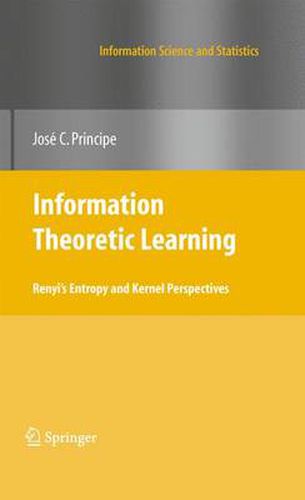Readings Newsletter
Become a Readings Member to make your shopping experience even easier.
Sign in or sign up for free!
You’re not far away from qualifying for FREE standard shipping within Australia
You’ve qualified for FREE standard shipping within Australia
The cart is loading…






This title is printed to order. This book may have been self-published. If so, we cannot guarantee the quality of the content. In the main most books will have gone through the editing process however some may not. We therefore suggest that you be aware of this before ordering this book. If in doubt check either the author or publisher’s details as we are unable to accept any returns unless they are faulty. Please contact us if you have any questions.
This bookisan outgrowthoften yearsof researchatthe Universityof Florida Computational NeuroEngineering Laboratory (CNEL) in the general area of statistical signal processing and machine learning. One of the goals of writing the book is exactly to bridge the two ?elds that share so many common problems and techniques but are not yet e?ectively collaborating. Unlikeotherbooks thatcoverthe state ofthe artinagiven?eld,this book cuts across engineering (signal processing) and statistics (machine learning) withacommontheme:learningseenfromthepointofviewofinformationt- orywithanemphasisonRenyi'sde?nitionofinformation.Thebasicapproach is to utilize the information theory descriptors of entropy and divergence as nonparametric cost functions for the design of adaptive systems in unsup- vised or supervised training modes. Hence the title: Information-Theoretic Learning (ITL). In the course of these studies, we discovered that the main idea enabling a synergistic view as well as algorithmic implementations, does not involve the conventional central moments of the data (mean and covariance). Rather, the core concept is the ?-norm of the PDF, in part- ular its expected value (? = 2), which we call the information potential. This operator and related nonparametric estimators link information theory, optimization of adaptive systems, and reproducing kernel Hilbert spaces in a simple and unconventional way.
$9.00 standard shipping within Australia
FREE standard shipping within Australia for orders over $100.00
Express & International shipping calculated at checkout
This title is printed to order. This book may have been self-published. If so, we cannot guarantee the quality of the content. In the main most books will have gone through the editing process however some may not. We therefore suggest that you be aware of this before ordering this book. If in doubt check either the author or publisher’s details as we are unable to accept any returns unless they are faulty. Please contact us if you have any questions.
This bookisan outgrowthoften yearsof researchatthe Universityof Florida Computational NeuroEngineering Laboratory (CNEL) in the general area of statistical signal processing and machine learning. One of the goals of writing the book is exactly to bridge the two ?elds that share so many common problems and techniques but are not yet e?ectively collaborating. Unlikeotherbooks thatcoverthe state ofthe artinagiven?eld,this book cuts across engineering (signal processing) and statistics (machine learning) withacommontheme:learningseenfromthepointofviewofinformationt- orywithanemphasisonRenyi'sde?nitionofinformation.Thebasicapproach is to utilize the information theory descriptors of entropy and divergence as nonparametric cost functions for the design of adaptive systems in unsup- vised or supervised training modes. Hence the title: Information-Theoretic Learning (ITL). In the course of these studies, we discovered that the main idea enabling a synergistic view as well as algorithmic implementations, does not involve the conventional central moments of the data (mean and covariance). Rather, the core concept is the ?-norm of the PDF, in part- ular its expected value (? = 2), which we call the information potential. This operator and related nonparametric estimators link information theory, optimization of adaptive systems, and reproducing kernel Hilbert spaces in a simple and unconventional way.